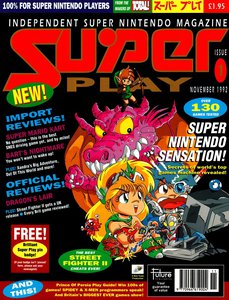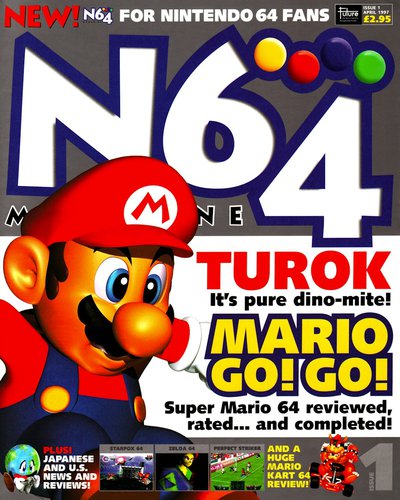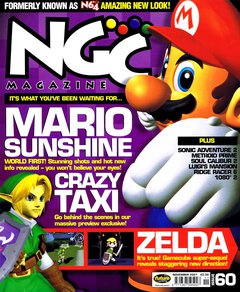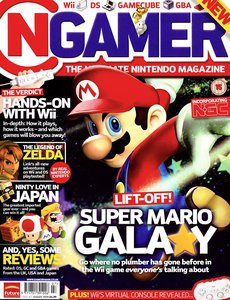First issues are probably the most important issue of any magazine to get right. They need to get the user hooked and encourage them to buy the next issue and beyond. For videogame magazines they are even more important as they often coincide with the launch of the console, with plenty of competition from rival magazines trying to get a market share. Magazines were a good companion piece as they often gave a buyers guide to what games and accessories to buy (or not to buy) for the console - or at least they did back in the day!
Super Play
 The first issue of Super Play launched 5 months after the SNES hit the UK, and was one of Future’s first forays into Videogame magazines. The whole “hook” of the magazine was the import market - future already had TOTAL! on shelves at the time, so Super Play was an attempt to get more of the market share.
The first issue of Super Play launched 5 months after the SNES hit the UK, and was one of Future’s first forays into Videogame magazines. The whole “hook” of the magazine was the import market - future already had TOTAL! on shelves at the time, so Super Play was an attempt to get more of the market share.
Importing was very lucrative at the time, with often games coming out in the USA months and even years before Europe got their hands on them as well as games getting a dodgy PAL conversion. Despite the console being out for nearly half a year, there still weren’t many UK games for the magazine to cover.
The first issue featured an 8 page look at the Super Nintendo hardware, comparing it to the NTSC versions. This really setup Super Play’s stall as an import centred magazine, as it thoroughly took apart the PAL system, looking specifically at the benefits of importing such as the borders and slowdown.
The main reviews focus was on USA and Japanese games, with plenty to say on Mario Kart. Many of the UK games released up to that point were also reviewed, although curiously they saved launch title Mario World until the next month.
The first issue also looked at every single game released so far in their “What Cart” section, although again this didn’t separate UK games from Import releases. Over 130 games were released in total up to that point, giving importers plenty of information about what was out there.
Find out more on the first issue of Super Play
N64 Magazine
 The first issue of N64 Magazine was gestating for 6 months, after Super Play was discontinued in October 1996. The work made sure the magazine hit the N64’s launch window, thereby helping to make sure people picked it up when they were buying their new games console.
The first issue of N64 Magazine was gestating for 6 months, after Super Play was discontinued in October 1996. The work made sure the magazine hit the N64’s launch window, thereby helping to make sure people picked it up when they were buying their new games console.
Fans were hooked by the breadth of information about the games reviewed, with the lack of UK releases - and releases generally - giving the team a great deal of space to work with - filling over half the magazine with reviews alone. All the other Japanese and US releases from the last 9 months were also reviewed, with Mario Kart 64 getting a big import review. Massive reviews would become a staple over the next year or so, as games were drip-fed into the UK market.
In order to get readers hooked, the first magazine had a free video attached, this gave a good insight into the games available as well as previewed future games - this was to become a staple for magazines going forward.
To perk up interest in the magazine, a feature ran in Gamesmaster during the months prior to its launch, this meant that there were quite a few letters about the N64, as well as what readers thought about what should be in the magazine as well as who should write for them. It’s fair to say that this contributed to a strong initial reader base.
As with Super Play, there was an in-depth feature on getting the N64 hooked up, information about what all the ports were for and information about the history of the console. Although this was mostly UK focussed for the first issue - they would cover import games in future issues.
Find out more on the first issue of N64 Magazine
NGC
 NGC actually had two first issues, covering the Japanese and European launches. With the second launch in issue 68, NGC became the biggest magazine, which certainly made it stand-out on the shop shelves.
NGC actually had two first issues, covering the Japanese and European launches. With the second launch in issue 68, NGC became the biggest magazine, which certainly made it stand-out on the shop shelves.
NGC was a direct continuation from N64 magazine, so it already had a pre-built reader base the initial magazine clearing up some loose ends and making it more Gamecube oriented, for example shortening down the directory from its monster 10 pages to a more comfortable 2 pages. They even had primarily the same staff, although Tim Weaver came back for a second stint as editor for the first NGC.
As with N64 magazine, both launches had media free with them, issue 60 again had a VHS, whilst issue 68 included a DVD - unfortunately this couldn’t be played on the Gamecube, but it could actually be played on PS2 and Xbox - their two main competitors at the time.
Issue 68 brought a complete redesign to the magazine, foregoing all of the previous links to N64 magazines, and brand new sections introduced, such as the NGC Compendium, including the rather infamous Lex Luthor’s Solve My Maze - poking fun at Superman 64’s maze minigame. As well as this issue 68 some of the UK launch line-up (67 had the first half), as well as some post launch stragglers, such as Smash Bros Melee. Unfortunately as this was only half of the launch line-up it didn’t provide the best snapshot to a potential newbie.
Find out more about issue 60 of NGC
Find out more about issue 68 of NGC
NGamer
 NGamer launched 3 Months before the Wii hit the shops, and although didn't carry on directly from NGC, the first issue was launched not long after the final issue of NGC was taken off sale. As with many of the early issues, the magazine had a free DVD. This DVD was a major selling factor for the magazine, as no other Nintendo Magazine at the time had similar free gifts - unfortunately this meant the magazine had a cover price of nearly £5 which was a bit more expensive than other magazines.
NGamer launched 3 Months before the Wii hit the shops, and although didn't carry on directly from NGC, the first issue was launched not long after the final issue of NGC was taken off sale. As with many of the early issues, the magazine had a free DVD. This DVD was a major selling factor for the magazine, as no other Nintendo Magazine at the time had similar free gifts - unfortunately this meant the magazine had a cover price of nearly £5 which was a bit more expensive than other magazines.
NGamer had major competition at the time in the form of the Official Nintendo Magazine - which had launched a few months earlier. This meant that NGamer had to differentiate itself, which it did well. ONM was the serious side and NGamer kept the more comedic tone that NGC and N64 were so good at.
NGamer also had World of Nintendo, a deeper look at things happening in the wider world of Nintendo and minimised the tips sections, preferring to find different ways to play your favourite games. There was also the magnificent Download section, looking at older games as well as games they wanted to see in the Wiis virtual console.
Once again, the magazine employed the talents of Will Overton, who produced great artwork to accompany an unnamed character in the reviews section and DR64 who introduced the Download section